Topics
Category
Era
Agricultural Depression, 1920–1934
Starving farm family that appealed for aid during an agricultural depression, Hollandale, Freeborn County, 1929.
Minnesota farmers enjoyed a period of prosperity in the 1910s that continued through World War I. Encouraged by the US government to increase production, they took out loans to buy more land and invest in new equipment. As war-torn countries recovered, however, the demand for US exports fell, and land values and prices for commodities dropped. Farmers found it hard to repay their loans—a situation worsened by the Great Depression and the drought years that followed.
The onset of World War I in 1914 sparked an economic boom for farmers in the United States. Demand for agricultural products soared as the war-ravaged countries of Europe could no longer produce needed supplies. This created a shortage that drove up prices for farm commodities. In Minnesota, the season-average price per bushel of corn rose from fifty-nine cents in 1914 to $1.30 in 1919. Wheat prices jumped from $1.05 per bushel to $2.34. The average price of hogs increased from $7.40 to $16.70 per hundred pounds, and the price of milk rose from $1.50 to $2.95 per hundred pounds.
To meet the demand, the US government encouraged farmers to produce more. In 1916, Congress passed the Federal Farm Loan Act, creating twelve federal land banks to provide long-term loans for farm expansion. Believing that the boom would continue, many farmers took advantage of this and other loan opportunities to invest in land, tractors, and other new labor-saving equipment at interest rates ranging from 5 to 7 percent. By 1920, 52.4 percent of the 132,744 Minnesota farms reporting to the Agricultural Census carried mortgage debt, totaling more than $254 million.
After the US entered the war in 1917 and continuing into the post-war years, 40 million acres of uncultivated land in the US went under the plow, including 30 million acres in the wheat- and corn-producing states of the Midwest. In Kittson County alone, wheat acreage increased from 93,000 acres prewar to 146,000 acres. Minnesota farmers had nearly 18.5 million acres under cultivation by 1929. The demand for land inflated the price of farm real estate, regardless of quality. The average price of Minnesota farm land more than doubled between 1910 and 1920, from $46 to $109 per acre.
After the end of the war, relief efforts kept the demand for US agricultural products high. Gross exports of all grains in 1918–1919 totaled 525,461,560 bushels. During that period, the US shipped more than 2.9 billion pounds of pork, 1.1 billion pounds of beef, and nearly 8.8 million pounds of dairy products to allied countries, various relief programs, and American Expeditionary Forces overseas.
Farmers continued to produce more, expecting demand and prices to remain stable. As Europe began to recover from the war, however, the US farm economy began a long downward trend that reached a crisis during the Great Depression. Minnesota farmers' gross cash income fell from $438 million in 1918 to $229 million in 1922. In 1932, it fell to $155 million.
With heavy debts to pay and improved farming practices and equipment making it easier to work more land, farmers found it hard to reduce production. The resulting large surpluses caused farm prices to plummet. From 1919 to 1920, corn tumbled from $1.30 per bushel to forty-seven cents, a drop of more than 63 percent. Wheat prices fell to $1.65 per bushel. The price of hogs dropped to $12.90 per hundred pounds.
As surpluses mounted, the federal government promoted lowering production. It also created programs designed to help stabilize prices. The goal was to achieve parity – to bring prices back to prewar levels and equalize the prices farmers received with the prices they paid for goods.
The passage of the Capper-Volstead Act on February 18, 1922 legalized the sale of farm commodities through farmer-owned cooperatives. Co-ops cut out the middlemen who often underpaid farmers for their products. Congress passed the Agricultural Appropriations Act later that year, creating the US Bureau of Agricultural Economics for economic research.
Foreign trade restrictions, such as the Fordney–McCumber Tariff (1922) and the Hawley-Smoot Tariff (1930), imposed high taxes on imports in an attempt to protect US farms and industry. International trading partners reacted by increasing import fees on American goods. US export of farm products declined, surpluses grew, and prices continued to drop. In 1932, Minnesota corn prices fell to twenty-eight cents per bushel, wheat dropped to forty-four cents per bushel, and the price of hogs fell 75 percent to $3.20 per hundred pounds.
With less demand for land, real estate values plunged to an average of $35 per acre by the late 1930s. Farmers struggled to repay loans for land that had lost its value. Rising property taxes, freight rates, and labor costs added to the financial hardships facing many farmers. In Minnesota, the average tax per acre increased from forty-six cents in 1913 to $1.45 in 1930.
The west-central counties of Minnesota suffered from the severe drought conditions of 1933–1934. A combination of poor farming methods and drought caused extensive soil erosion. A grasshopper infestation compounded crop losses in many western counties.
Farmers across the country began to default on their loans. An estimated sixty of every 1,000 farmers in the US either lost their farms or filed for bankruptcy. From 1926 to 1932, 1,442 farms totaling 258,587 acres were lost to foreclosure in Minnesota. Marshall County had the highest number of foreclosures during this period with 191. It was followed by Kittson County with 127 and Pennington County with 123. From 1922 to 1932, 2,866 Minnesota farmers declared bankruptcy.
In spite of the hardships, Minnesota's rural population increased during the 1930s. Many who lost farms to foreclosure remained on the property as tenants. Others moved from urban areas to the country.
On July 29, 1932, farmers met in St. Cloud to organize the Minnesota Farmers Holiday Association. Members staged a thirty-day strike to call a moratorium on foreclosures. The following April the state legislature passed a bill declaring a state of emergency for Minnesota farmers and approving a mortgage moratorium.
Congress passed several farm relief measures in 1933. The first Agricultural Adjustment Act established the Agricultural Adjustment Administration (AAA) and gave it the power to pay subsidies to farmers who voluntarily reduced production. The Federal Emergency Relief Act (FERA), the forerunner of the Works Progress Administration (WPA), provided relief for both urban and rural residents through work projects.
The Resettlement Administration (RA), begun in 1935, moved 300 families from poor quality land in northeastern Minnesota to better farms through programs like the Beltrami Island Project. The RA was replaced by the Farm Security Administration in 1937.
The Supreme Court ruled in 1936 that the AAA was unconstitutional and suspended farm subsidies. Congress, in turn, responded with the Soil Conservation and Domestic Allotment Act. In 1938, a second AAA bill passed that controlled crop production through acreage allotment and soil conservation.
By December 1934, 18 percent of Minnesota's total population was on some form of relief and had received a total of $67,619,854 in benefits. From 1933 to 1936, rural and urban residents in seventy-seven Minnesota counties received federal aid payments. By the late 1930s, the US farm economy finally began to improve.
Bibliography
Amundson, Roland C., and Lewis J. Rotman. "Depression Jurisprudence Revisited: Minnesota's Moratorium on Mortgage Foreclosure." William Mitchell Law Review 10, no. 4, Article 7 (1984): 805–850.
http://open.mitchellhamline.edu/cgi/viewcontent.cgi?article=2614&context=wmlr
Boeckel, R. M. CQ Press. Foreign Trade of the United States. (1930).
http://library.cqpress.com/cqresearcher/cqresrre1930110100
“Minnesota and Iowa." Minnesota History 52, no. 3 (Fall 1990): 100–111.
http://collections.mnhs.org/mnhistorymagazine/articles/52/v52i03p100-111.pdf
Cieslik, Thomas, David Felsen, and Akis Kalaitzidis, eds. Immigration: A Documentary and Reference Guide. Westport, CT: Greenwood Press, 2009.
Cronin, Francis D. Areas of Intense Drought Distress, 1930–1936. Washington, D.C.: United States Government Printing Office, 1937.
Department of Rural Credit. "Annual Report of the Department of Rural Credit, State of Minnesota." St. Paul: Department of Rural Credit, 1926.
——— . "Annual Report of the Department of Rural Credit, State of Minnesota." St. Paul: Department of Rural Credit, 1928.
——— . "Annual Report of the Department of Rural Credit, State of Minnesota." St. Paul: Department of Rural Credit, 1930.
——— . "Annual Report of the Department of Rural Credit, State of Minnesota." St. Paul: Department of Rural Credit, 1932.
Dowell, A. A. Corporate-Owned Farm Land in Minnesota, 1936–1940. Bulletin 357. St. Paul: University of Minnesota Agricultural Experiment Station, January 1942.
——— . The Trend in Sale Prices of Farm Real Estate in Minnesota. Bulletin 338. St. Paul: University of Minnesota Agricultural Experiment Station, April 1939.
Encyclopædia Britannica. Smoot–Hawley Tariff Act.
https://www.britannica.com/topic/Smoot-Hawley-Tariff-Act
Encyclopedia.com. Gale Encyclopedia of U.S. Economic History. "Fordney-McCumber Tariff."
http://www.encyclopedia.com/history/encyclopedias-almanacs-transcripts-and-maps/fordney-mccumber-tariff
Encyclopedia.com. Major Acts of Congress. "Farm Credit Act of 1933."
http://www.encyclopedia.com/history/encyclopedias-almanacs-transcripts-and-maps/farm-credit-act-1933
Farm Credit Administration. History of FCA and FCS.
https://www.fca.gov/about/history/historyFCA_FCS.html
Fitzharris, Joseph C. "Minnesota Agricultural Growth, 1880–1970." St. Paul: University of Minnesota, Institute of Agriculture, Forestry and Home Economics, 1976.
General Laws of Minnesota for 1933, Chapter 339.
https://www.revisor.mn.gov/laws/?year=1933&type=0&group=Session+Law&doctype=Chapter&id=339
Gile, B. M., and J. D. Black. The Agricultural Situation in Minnesota. Technical Bulletin 55. St. Paul: University Farm, August 1939.
Johnson, E. C. Farm Mortgage Foreclosures in Minnesota. Bulletin 293. St. Paul: University of Minnesota Agricultural Experiment Station, December 1932.
——— . Farm Real Estate Values in Minnesota. Bulletin 307. St. Paul: University of Minnesota Agricultural Experiment Station, July 1934.
Marquardt, Robert E. Minnesota Agriculture – Prices, 1867–1959. St. Paul: [Minnesota Department of Agriculture?], 1959.
McNelly, C. S. The County Agent Story, the Impact of Extension Work on Farming and Country Life, Minnesota. Berryville, AR: Braswell Print Co., [1960].
Minnesota Agricultural Experiment Station, 1885–1935. [St. Paul, MN]: University of Minnesota, Agricultural Experiment Station, [1935].
Minnesota Emergency Relief Administration. Manual for Livestock Relief Managers. St. Paul: Minnesota Emergency Relief Administration, 1934.
Murchie, Robert Welch, and Merrill E. Jarchow. Population Trends in Minnesota. Bulletin 327. St. Paul: University of Minnesota Agricultural Experiment Station, May 1936.
Olcott, Margaret T., and Louise O. Bercaw, comps. State Measures for the Relief of Agricultural Indebtedness in the United States 1933 and 1934. Washington, DC: United States Department of Agriculture, Bureau of Agricultural Economics, 1934.
Rural Credit Bureau. Annual Report of the Department of Rural Credit, State of Minnesota. St. Paul: Department of Rural Credit, 1926, 1928, 1930, and 1932. [See Ag Stats – Farm Mortgage Debt tab]
Saloutos, Theodore. The American Farmer and the New Deal. Ames, IA: Iowa State University Press, 1982.
Smiley, Gene. "Developments in Agriculture and Manufacturing: 1920–1940. In The American Economy in the 20th Century, 3-1–3-17. Mason, OH: South-Western Publishing Company, 1993.
http://www.qc-econ-bba.com/instructors/Edelstein11/ECON224/03.pdf
Tweton, D. Jerome. Depression: Minnesota in the Thirties. Fargo, ND: North Dakota Institute for Regional Studies, 1981.
United States Department of Agriculture. Census of Agriculture Historical Archive.
http://agcensus.mannlib.cornell.edu/AgCensus/homepage.do
United State Department of Agriculture Crop Reporting Board. Statistical Bulletin 319. Prices Paid by Farmers for Commodities and Services, United States, 1910–1960. Washington, DC: US Department of Agriculture, [1962].
Related Resources
Primary
Boss, Andrew. Bulletin 327: "Population Trends in Minnesota." St. Paul: University of Minnesota Agricultural Experiment Station, 1937.
Drought Relief Applications, 1933
Minnesota Executive Council
State Archives Collection, Minnesota Historical Society, St. Paul
Description: Applications for livestock feed and/or fuel and other farm needs as a result of crop losses in the drought of 1933, which were submitted to the Executive Council's Drought Relief Committee. Applications are arranged alphabetically by county; counties with large number of applications may be subdivided by township.
The Liquidator. St. Paul: Minnesota Department of Rural Credit, 1934–.
Miscellaneous Records, 1929–1950
Minnesota Department of Agriculture
State Archives Collection, Minnesota Historical Society, St. Paul
http://www2.mnhs.org/library/findaids/agric003.pdf
Description: Includes drought relief correspondence and reports, mainly concerning emergency livestock feed (1934–1935).
Nodland, Truman R., A. J. Schwantes, and Ross V. Baumann. Use of Farm Tractors in Minnesota. Washington: US Department of Agriculture, Bureau of Agricultural Economics, 1940.
Price, Hugh Bruce. Farmers' Co-operation in Minnesota, 1917–1922. St. Paul: University Farm, 1923.
United States Department of Agriculture. Regulations Relative to Loans for Seed, Feed, and/or Fuel and Oil for Tractors in 1931. Washington, D.C.: The Department of Agriculture, 1931.
Wallace, Henry A. America Must Choose: The Advantages and Disadvantages of World Trade, and of a Planned Middle Course. New York: Foreign Policy Association; Boston: World Peace Foundation, 1934.
Zimmerman, Carle C., and John D. Black. The Marketing Attitudes of Minnesota Farmers. St. Paul: University Farm, 1926.
Secondary
Granger, Susan, and Scott Kelly. "Historic Context Study of Minnesota Farms, 1820–1960, Vol. 1." St. Paul: Minnesota Department of Transportation, 2005.
Norris, Jim. "Bargaining for Beets: Migrants and Growers in the Red River Valley. Minnesota History 58, no. 4 (Winter 2002–2003): 196–209. http://collections.mnhs.org/MNHistoryMagazine/articles/58/v58i04p196-209.pdf
Web
Library of Congress. Teacher Resources: Great Depression and World War II, 1929–1945. Originally found at: http://www.loc.gov/teachers/classroommaterials/presentationsandactivities/presentations/timeline/depwwii/dustbowl/
Madsen, Jakob B. Trade Barriers and the Collapse of World Trade During the Great Depression. http://www.people.vcu.edu/~lrazzolini/GR2001.pdf
Minnesota Agriculture in the Classroom.
http://minnesota.agclassroom.org/
Minnesota Farm Bureau.
http://www.fbmn.org/
Minnesota Farmer's Union.
http://www.mfu.org/
National Agriculture in the Classroom. Growing a Nation: The Story of American Agriculture. Historical Timeline.
https://www.agclassroom.org/gan/timeline/index.htm
National Drought Mitigation Center. Drought Basics.
https://drought.unl.edu/Education/DroughtBasics.aspx
Related Images
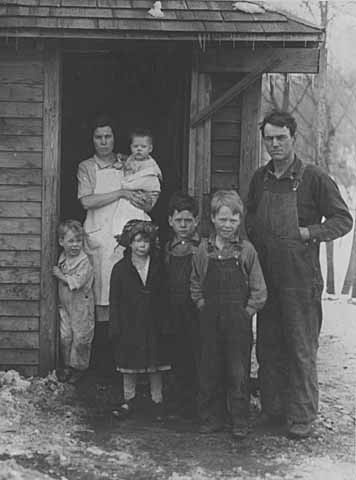
Farm family that applied for aid
Starving farm family that appealed for aid during an agricultural depression, Hollandale, Freeborn County, 1929.
Holding Location
More Information
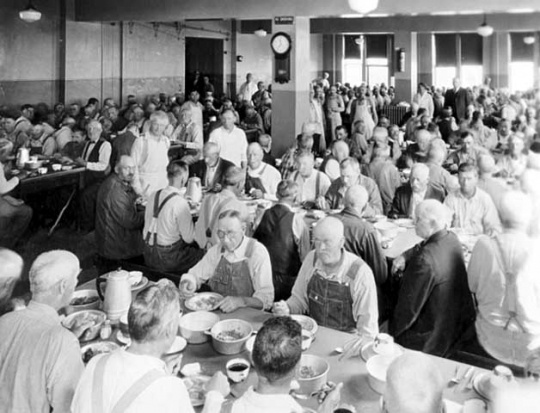
Workers on State Emergency Relief Administration
Workers on State Emergency Relief Administration (SERA) farm near Duluth, Lake County, 1935.
Holding Location
Articles
More Information
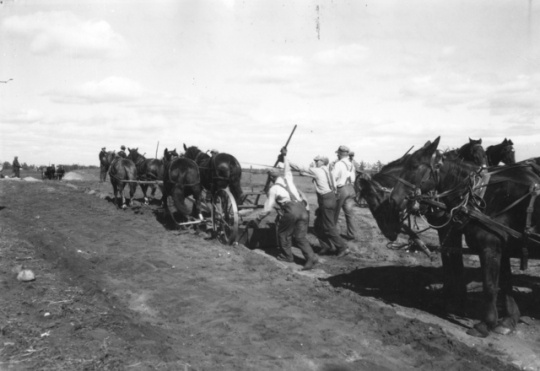
Farm to market road construction
Federal Emergency Relief Administration farm to market road construction project near Alexandria, 1936.
Holding Location
Articles
More Information
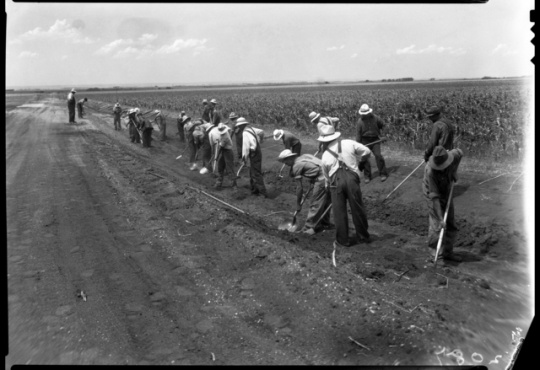
Drought farmers working on a farm to market road
Drought farmers working on a farm to market road in Foster Township, south of Beardsley in Big Stone County, 1936.
Holding Location
Articles
More Information

Farmers at Minneapolis produce market during the truckers' strike
Farmers who braved the picket lines to reach the Minneapolis city produce market during the truckers' strike, 1934. Photograph by the Minneapolis Tribune.
Holding Location
More Information
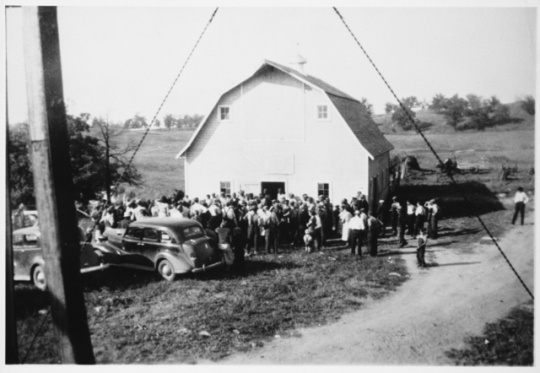
Auction at Figura farm, Burnsville
Auction at Figura farm, Burnsville, 1938.
Holding Location
Articles
More Information
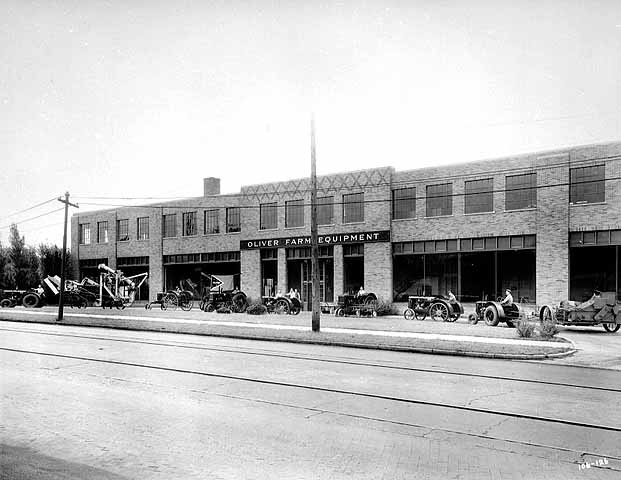
Oliver Farm Equipment
Oliver Farm Equipment, 3310 Como Avenue, Minneapolis, 1934.
Holding Location
Articles
More Information
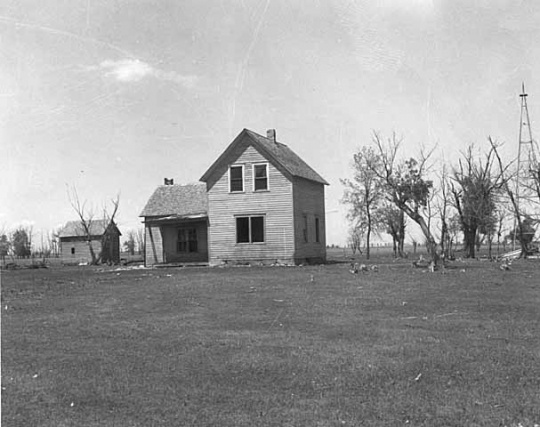
Farm abandoned after years of drought
Farm abandoned after successive years of drought, possibly near Breckenridge in Wilkin County, 1939.
Holding Location
Articles
More Information
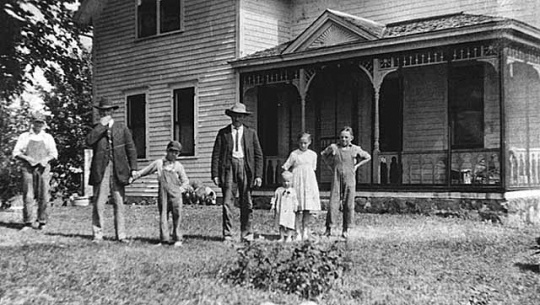
Mainquist farm house
Mainquist farm house, Rockford Township, Wright County, ca. 1920.
Holding Location
Articles
More Information
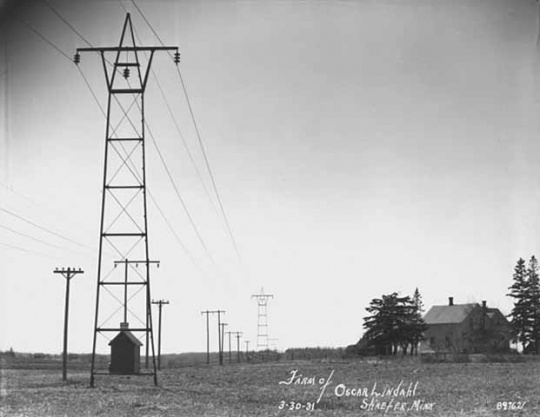
Rural electrical transmission lines
Rural electrical transmission lines on the farm of Oscar Lindahl, Schaefer, Chisago County, 1931. Photograph by Norton & Peel.
Holding Location
Articles
More Information
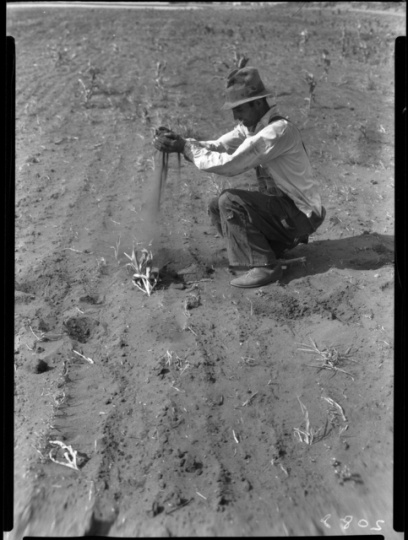
Corn destroyed by cut worms and heat
A combination of cut worms and heat has destroyed the corn on this farm, six miles east of Appleton in Swift County, 1936.
Holding Location
More Information

Farm in windbreak near Lamberton
Farm in windbreak near Lamberton, Redwood County, 1936. Photograph by Napoleon Noel Nadeau.
Holding Location
Articles
More Information
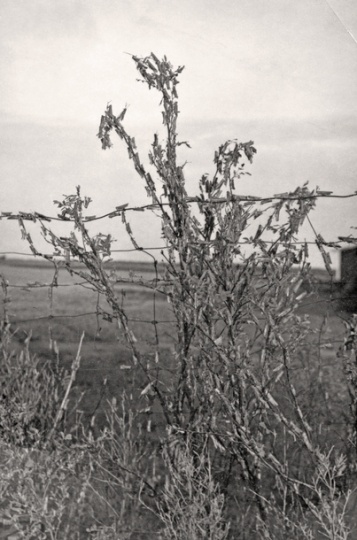
Grasshoppers waiting for the temperature to rise
Grasshoppers waiting for the temperature to rise before moving into a corn field in Marshall, Minnesota, ca. 1930s.
Holding Location
More Information
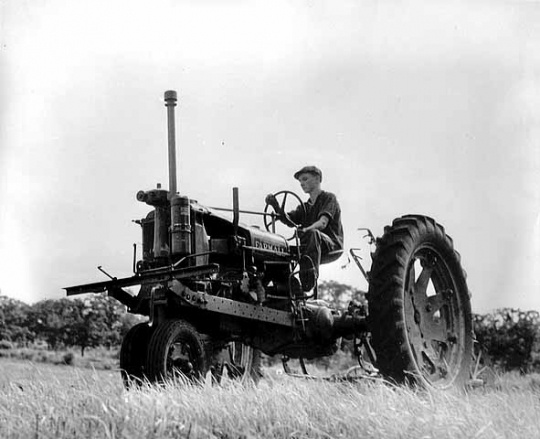
Farmall tractor on the farm of Mike O'Boyle
Farmall tractor on the farm of Mike O'Boyle, St. Paul Park, 1938.
Holding Location
Articles
More Information
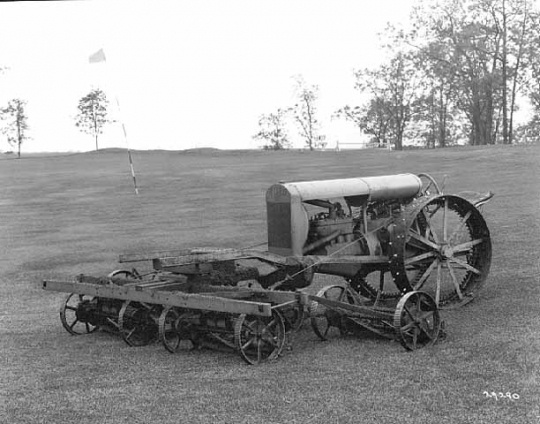
Toro Motor Company farm machinery
Toro Motor Company farm machinery, ca. 1920–1925. Photograph by C. J. Hibbard.
Holding Location
Articles
More Information
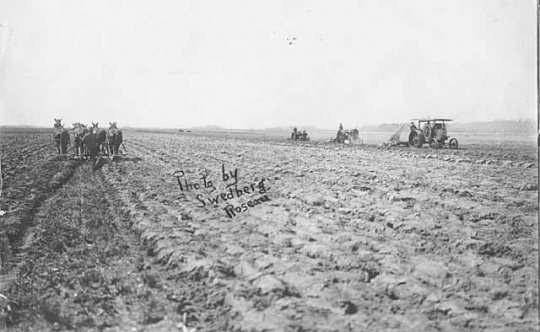
Horse and tractor farming in Roseau County
The old and the new: horse and tractor farming in Roseau County, ca. 1920. Photograph by Swedberg.
Holding Location
Articles
More Information

Contour cultivation of corn
Contour cultivation of corn on the Walter Fox farm near Faribault, 1938.
Holding Location
More Information
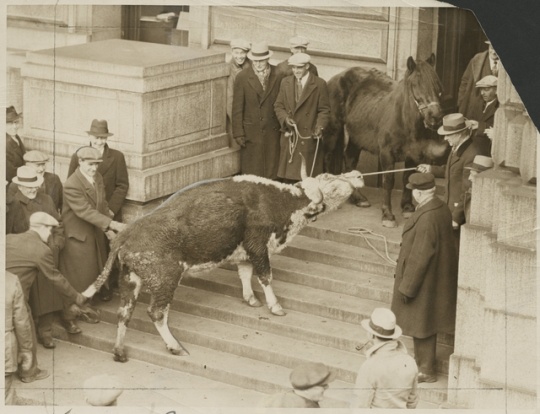
Starving animals brought to the State Capitol by farmers
Starving cow and horse brought to the State Capitol by farmers to dramatize their demands for relief, 1935. Photograph by the St. Paul Daily News.
Holding Location
Articles
More Information
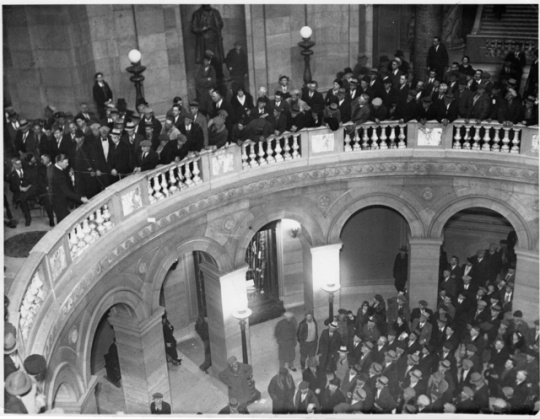
Farmers at the Minnesota State Capitol
Thousands of farmers gather at the Minnesota State Capitol to hear Governor Floyd B. Olson talk on farm relief, ca. 1935. Photograph by George E. Luxton.
Holding Location
Articles
More Information
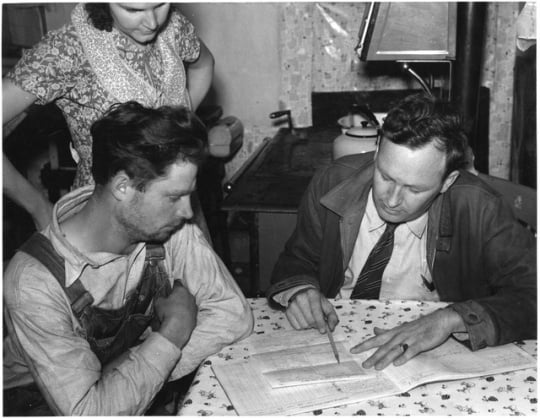
Farmers talking with Farm Security Administration County Supervisor
A Wilkin County farmer and his wife talk over the farm plan with the Farm Security Administration County Supervisor, ca. 1937. Photograph by the Farm Security Administration.
Holding Location
Articles
More Information
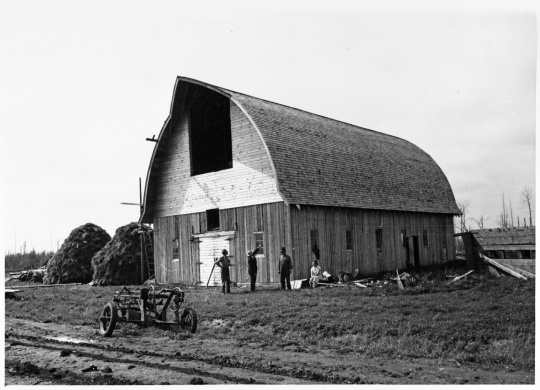
New barn constructed on Beltrami Island Relocation Project
New barn constructed on Beltrami Island Relocation Project by FSA Borrower with technical assistance given by FSA Engineer. The total cost of this barn was less than $400, ca. 1937. Photograph by Vachon, the Farm Security Administration.
Holding Location
Articles
More Information
Related Articles
Turning Point
The agricultural boom of the 1910s ends when Europe begins to recover from World War I in 1920, leaving US farmers with heavy debts and large surpluses that cause prices to fall.
Chronology
1914
1916
1921
1922
1922
1929
1930
1932
1932
1933
1933
1933
1933
1936
1936
1938
Bibliography
Amundson, Roland C., and Lewis J. Rotman. "Depression Jurisprudence Revisited: Minnesota's Moratorium on Mortgage Foreclosure." William Mitchell Law Review 10, no. 4, Article 7 (1984): 805–850.
http://open.mitchellhamline.edu/cgi/viewcontent.cgi?article=2614&context=wmlr
Boeckel, R. M. CQ Press. Foreign Trade of the United States. (1930).
http://library.cqpress.com/cqresearcher/cqresrre1930110100
“Minnesota and Iowa." Minnesota History 52, no. 3 (Fall 1990): 100–111.
http://collections.mnhs.org/mnhistorymagazine/articles/52/v52i03p100-111.pdf
Cieslik, Thomas, David Felsen, and Akis Kalaitzidis, eds. Immigration: A Documentary and Reference Guide. Westport, CT: Greenwood Press, 2009.
Cronin, Francis D. Areas of Intense Drought Distress, 1930–1936. Washington, D.C.: United States Government Printing Office, 1937.
Department of Rural Credit. "Annual Report of the Department of Rural Credit, State of Minnesota." St. Paul: Department of Rural Credit, 1926.
——— . "Annual Report of the Department of Rural Credit, State of Minnesota." St. Paul: Department of Rural Credit, 1928.
——— . "Annual Report of the Department of Rural Credit, State of Minnesota." St. Paul: Department of Rural Credit, 1930.
——— . "Annual Report of the Department of Rural Credit, State of Minnesota." St. Paul: Department of Rural Credit, 1932.
Dowell, A. A. Corporate-Owned Farm Land in Minnesota, 1936–1940. Bulletin 357. St. Paul: University of Minnesota Agricultural Experiment Station, January 1942.
——— . The Trend in Sale Prices of Farm Real Estate in Minnesota. Bulletin 338. St. Paul: University of Minnesota Agricultural Experiment Station, April 1939.
Encyclopædia Britannica. Smoot–Hawley Tariff Act.
https://www.britannica.com/topic/Smoot-Hawley-Tariff-Act
Encyclopedia.com. Gale Encyclopedia of U.S. Economic History. "Fordney-McCumber Tariff."
http://www.encyclopedia.com/history/encyclopedias-almanacs-transcripts-and-maps/fordney-mccumber-tariff
Encyclopedia.com. Major Acts of Congress. "Farm Credit Act of 1933."
http://www.encyclopedia.com/history/encyclopedias-almanacs-transcripts-and-maps/farm-credit-act-1933
Farm Credit Administration. History of FCA and FCS.
https://www.fca.gov/about/history/historyFCA_FCS.html
Fitzharris, Joseph C. "Minnesota Agricultural Growth, 1880–1970." St. Paul: University of Minnesota, Institute of Agriculture, Forestry and Home Economics, 1976.
General Laws of Minnesota for 1933, Chapter 339.
https://www.revisor.mn.gov/laws/?year=1933&type=0&group=Session+Law&doctype=Chapter&id=339
Gile, B. M., and J. D. Black. The Agricultural Situation in Minnesota. Technical Bulletin 55. St. Paul: University Farm, August 1939.
Johnson, E. C. Farm Mortgage Foreclosures in Minnesota. Bulletin 293. St. Paul: University of Minnesota Agricultural Experiment Station, December 1932.
——— . Farm Real Estate Values in Minnesota. Bulletin 307. St. Paul: University of Minnesota Agricultural Experiment Station, July 1934.
Marquardt, Robert E. Minnesota Agriculture – Prices, 1867–1959. St. Paul: [Minnesota Department of Agriculture?], 1959.
McNelly, C. S. The County Agent Story, the Impact of Extension Work on Farming and Country Life, Minnesota. Berryville, AR: Braswell Print Co., [1960].
Minnesota Agricultural Experiment Station, 1885–1935. [St. Paul, MN]: University of Minnesota, Agricultural Experiment Station, [1935].
Minnesota Emergency Relief Administration. Manual for Livestock Relief Managers. St. Paul: Minnesota Emergency Relief Administration, 1934.
Murchie, Robert Welch, and Merrill E. Jarchow. Population Trends in Minnesota. Bulletin 327. St. Paul: University of Minnesota Agricultural Experiment Station, May 1936.
Olcott, Margaret T., and Louise O. Bercaw, comps. State Measures for the Relief of Agricultural Indebtedness in the United States 1933 and 1934. Washington, DC: United States Department of Agriculture, Bureau of Agricultural Economics, 1934.
Rural Credit Bureau. Annual Report of the Department of Rural Credit, State of Minnesota. St. Paul: Department of Rural Credit, 1926, 1928, 1930, and 1932. [See Ag Stats – Farm Mortgage Debt tab]
Saloutos, Theodore. The American Farmer and the New Deal. Ames, IA: Iowa State University Press, 1982.
Smiley, Gene. "Developments in Agriculture and Manufacturing: 1920–1940. In The American Economy in the 20th Century, 3-1–3-17. Mason, OH: South-Western Publishing Company, 1993.
http://www.qc-econ-bba.com/instructors/Edelstein11/ECON224/03.pdf
Tweton, D. Jerome. Depression: Minnesota in the Thirties. Fargo, ND: North Dakota Institute for Regional Studies, 1981.
United States Department of Agriculture. Census of Agriculture Historical Archive.
http://agcensus.mannlib.cornell.edu/AgCensus/homepage.do
United State Department of Agriculture Crop Reporting Board. Statistical Bulletin 319. Prices Paid by Farmers for Commodities and Services, United States, 1910–1960. Washington, DC: US Department of Agriculture, [1962].
Related Resources
Primary
Boss, Andrew. Bulletin 327: "Population Trends in Minnesota." St. Paul: University of Minnesota Agricultural Experiment Station, 1937.
Drought Relief Applications, 1933
Minnesota Executive Council
State Archives Collection, Minnesota Historical Society, St. Paul
Description: Applications for livestock feed and/or fuel and other farm needs as a result of crop losses in the drought of 1933, which were submitted to the Executive Council's Drought Relief Committee. Applications are arranged alphabetically by county; counties with large number of applications may be subdivided by township.
The Liquidator. St. Paul: Minnesota Department of Rural Credit, 1934–.
Miscellaneous Records, 1929–1950
Minnesota Department of Agriculture
State Archives Collection, Minnesota Historical Society, St. Paul
http://www2.mnhs.org/library/findaids/agric003.pdf
Description: Includes drought relief correspondence and reports, mainly concerning emergency livestock feed (1934–1935).
Nodland, Truman R., A. J. Schwantes, and Ross V. Baumann. Use of Farm Tractors in Minnesota. Washington: US Department of Agriculture, Bureau of Agricultural Economics, 1940.
Price, Hugh Bruce. Farmers' Co-operation in Minnesota, 1917–1922. St. Paul: University Farm, 1923.
United States Department of Agriculture. Regulations Relative to Loans for Seed, Feed, and/or Fuel and Oil for Tractors in 1931. Washington, D.C.: The Department of Agriculture, 1931.
Wallace, Henry A. America Must Choose: The Advantages and Disadvantages of World Trade, and of a Planned Middle Course. New York: Foreign Policy Association; Boston: World Peace Foundation, 1934.
Zimmerman, Carle C., and John D. Black. The Marketing Attitudes of Minnesota Farmers. St. Paul: University Farm, 1926.
Secondary
Granger, Susan, and Scott Kelly. "Historic Context Study of Minnesota Farms, 1820–1960, Vol. 1." St. Paul: Minnesota Department of Transportation, 2005.
Norris, Jim. "Bargaining for Beets: Migrants and Growers in the Red River Valley. Minnesota History 58, no. 4 (Winter 2002–2003): 196–209. http://collections.mnhs.org/MNHistoryMagazine/articles/58/v58i04p196-209.pdf
Web
Library of Congress. Teacher Resources: Great Depression and World War II, 1929–1945. Originally found at: http://www.loc.gov/teachers/classroommaterials/presentationsandactivities/presentations/timeline/depwwii/dustbowl/
Madsen, Jakob B. Trade Barriers and the Collapse of World Trade During the Great Depression. http://www.people.vcu.edu/~lrazzolini/GR2001.pdf
Minnesota Agriculture in the Classroom.
http://minnesota.agclassroom.org/
Minnesota Farm Bureau.
http://www.fbmn.org/
Minnesota Farmer's Union.
http://www.mfu.org/
National Agriculture in the Classroom. Growing a Nation: The Story of American Agriculture. Historical Timeline.
https://www.agclassroom.org/gan/timeline/index.htm
National Drought Mitigation Center. Drought Basics.
https://drought.unl.edu/Education/DroughtBasics.aspx






















